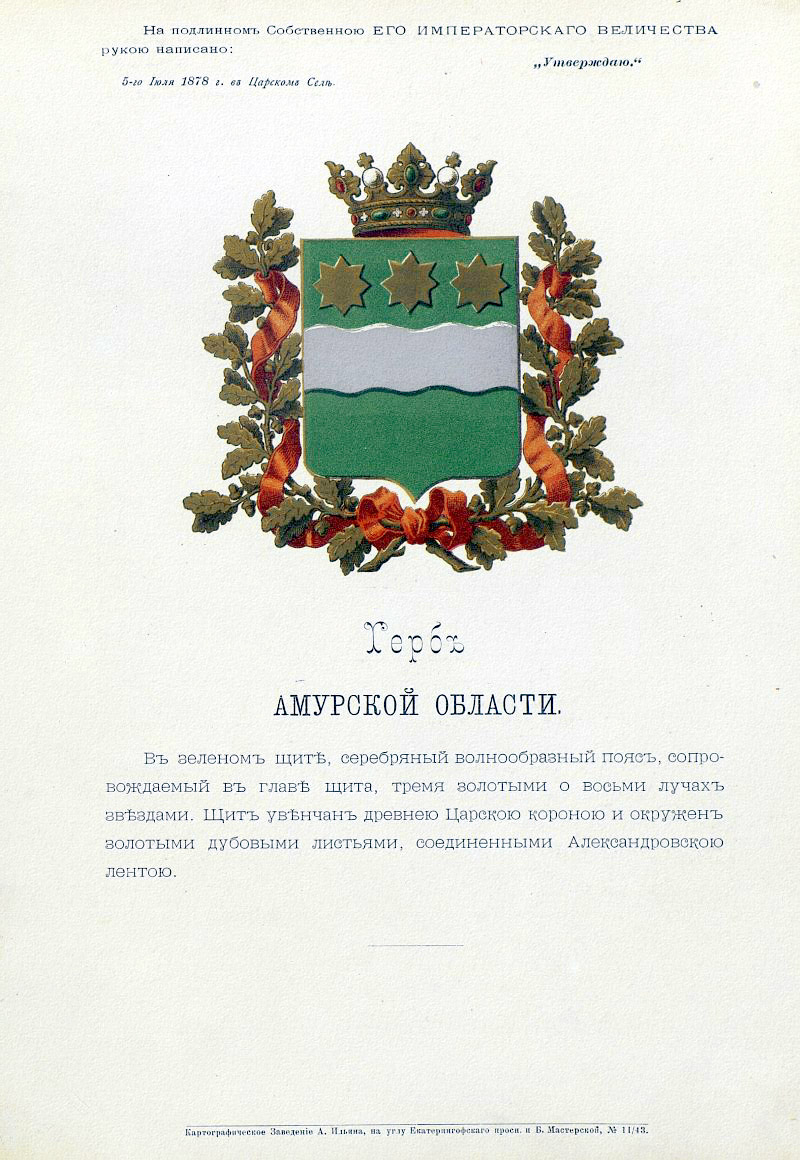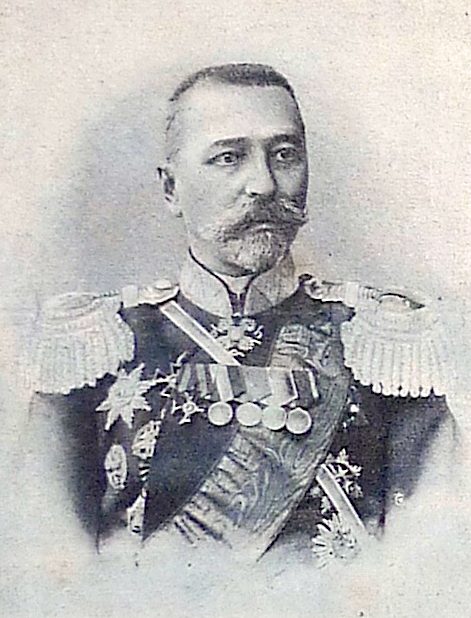|
Amur Oblast (Russian Empire)
The Amur Oblast with the center in Blagoveshchensk was formed on December 20, 1858 by the Personal Decree No. 33862. By this Decree, on the proposal of the Governor–General of Eastern Siberia and the Siberian Committee, the Amur Region was made up of lands "located on the left bank of the Amur River, starting from the junction of the Shilka and Argun Rivers or from the borders of the Trans–Baikal and Yakutsk Oblasts, along the entire course of the Amur, to the mouth of the river Ussuri and to the new border of the Primorsky Oblast". General characteristics The vast, little–explored area of Eastern Siberia along the left bank of the middle reaches of the Amur, mainly included the river areas of 2 large tributaries of the Amur – Zeya and Bureya. Formerly it belonged to China and was ceded to Russia in 1858 under the Aigun Treaty. *Area – 449,500 square kilometers; *Population – 62,640 people; *Main City – Blagoveshchensk (at the mouth of the Zeya). The Amur Oblast ... [...More Info...] [...Related Items...] OR: [Wikipedia] [Google] [Baidu] |
Oblast
An oblast (; ; Cyrillic (in most languages, including Russian and Ukrainian): , Bulgarian: ) is a type of administrative division of Belarus, Bulgaria, Kazakhstan, Kyrgyzstan, Russia, and Ukraine, as well as the Soviet Union and the Kingdom of Yugoslavia. Official terms in successor states of the Soviet Union differ, but some still use a cognate of the Russian term, e.g., ''vobłasć'' (''voblasts'', ''voblasts'', official orthography: , Taraškievica: , ) is used for regions of Belarus, ' (plural: ') for regions of Kazakhstan, and ''oblusu'' (') for regions of Kyrgyzstan. The term is often translated as "area", "zone", "province" or "region". The last translation may lead to confusion, because "raion" may be used for other kinds of administrative division, which may be translated as "region", "district" or "county" depending on the context. Unlike "province", translations as "area", "zone", and "region" may lead to confusion because they have very common meanings other t ... [...More Info...] [...Related Items...] OR: [Wikipedia] [Google] [Baidu] |
Svobodny, Amur Oblast
Svobodny (russian: Свобо́дный) is a town in Amur Oblast, Russia, located on the right bank of the Zeya River, north of Blagoveshchensk, the administrative center of the oblast. Population: 63,889 ( 2002 Census); History It was founded in 1912 in conjunction with the construction of the Amur RailwayPospelov, p. 26 (the Trans-Siberian Railway's "bypass" route, which was to provide a railway connection from European Russia to the Pacific entirely over the Russian soil, without crossing the north-eastern China). It was originally named ''Alexeyevsk'' (), in honor of the then crown prince Alexey. In 1917, the town was renamed Svobodny, Russian for ''free''. During the Stalin era, the ''BAMLag'' prison camp was built in Svobodny, with the intention of providing forced labor for the planned construction of the Baikal-Amur Mainline. The camp became one of the largest in the gulag system, with ca. 190,300 convicts in October 1935. The camp claimed the lives of th ... [...More Info...] [...Related Items...] OR: [Wikipedia] [Google] [Baidu] |
Brockhaus And Efron Encyclopedic Dictionary
The ''Brockhaus and Efron Encyclopaedic Dictionary'' (Russian: Энциклопедический словарь Брокгауза и Ефрона, abbr. ЭСБЕ, tr. ; 35 volumes, small; 86 volumes, large) is a comprehensive multi-volume encyclopaedia in Russian. It contains 121,240 articles, 7,800 images, and 235 maps. It was published in Imperial Russia in 1890–1907, as a joint venture of Leipzig and St Petersburg publishers. The articles were written by the prominent Russian scholars of the period, such as Dmitri Mendeleev and Vladimir Solovyov. Reprints have appeared following the dissolution of the Soviet Union. History In 1889, the owner of one of the St. Petersburg printing houses, Ilya Abramovich Efron, at the initiative of Semyon Afanasyevich Vengerov, entered into an agreement with the German publishing house F. A. Brockhaus for the translation into Russian of the large German encyclopaedic dictionary ( de) into Russian as , published by the same publishin ... [...More Info...] [...Related Items...] OR: [Wikipedia] [Google] [Baidu] |
Ministry Of Internal Affairs Of The Russian Empire
, image = Ministry of Interior building. Saint Petersburg.jpg , logo = Emblem of the Ministry of the Interior of the Russian Empire.svg , logo_width = , logo_caption = , formed = , dissolved = , preceding1 = Ministry of Police of the Russian Empire , superseding1 = Ministry of Internal Affairs of the Russian Republic , superseding2 = Cheka , jurisdiction = Council of Ministers of the Russian Empire , headquarters = 57, Fontanka River Embankment, Saint Petersburg, Russian Empire , region_code = RU , employees = , budget = , minister1_name = Viktor Kochubey , minister1_pfo = first , minister2_name = Alexander Protopopov , minister2_pfo = last , child1_agency = Police Department of Russia The Ministry of Internal Affairs of the Russian Empire () was the state executive authority of the Council of Ministers of the Russian Empire, which carried out administrative functions in the areas of state security, public security, law enforcement, leadership of loca ... [...More Info...] [...Related Items...] OR: [Wikipedia] [Google] [Baidu] |
Dmitry Putyata
Dmitry Vasilyevich Putyata (russian: Дмитрий Васильевич Путята) was a General of the Imperial Russian Army and a Russian explorer of the Pamir Mountains. In 1883 he explored Karakul Lake, Tashkurgan Town, the Bendersky Pass to the Wakhan Valley and westward along the Ghunt River. He covered more territory than any previous or subsequent expedition. Thomas Middleton and Hew Thomas, "Tajikistan and the High Pamirs", 2008 In the 1890s Putyata served on Russian General Staff as a specialist on China. In the late 1890s, Putyata as a military Attaché to Korea was sent to Korean Empire to modernize the Imperial Korean Army with some other officers as a request of Min Young-hwan Min Yeong-hwan (민영환, 閔泳煥; 7 August 1861 - 30 November 1905) was a politician, diplomat, and general of the Korean Empire and known as a conservative proponent for reform. He was born in Seoul into the powerful Yeoheung Min clan whi ..., the Minister of War of Korean Empir ... [...More Info...] [...Related Items...] OR: [Wikipedia] [Google] [Baidu] |
Nanai People
The Nanai people are a Tungusic people of East Asia who have traditionally lived along Heilongjiang (Amur), Songhuajiang (Sunggari) and Wusuli River on the Middle Amur Basin. The ancestors of the Nanai were the Jurchens of northernmost Manchuria (Outer Manchuria). The Nanai/Hezhe language belongs to the Manchu-Tungusic languages. According to the 2010 census there were 12,003 Nanai in Russia. Name Common names for these people include нанай/Nanai (meaning 'natives, locals, people of the land/earth'); self-designation Hezhen (means 'people of the Orient'); russian: нанайцы ; ; . There are also terms formerly in use: Goldi, Golds, Goldes, Heje, and Samagir. Own names are ( and ) and (). means 'land, earth, ground, country' or, in this context, 'native, local' and , , means 'people' in different dialects. The Russian linguist L. I. Sem gives the self-name in the Cyrillic form, ''хэǯэ най'' (''Hezhe nai'') or ''хэǯэны'' (''Hezheni''), and ... [...More Info...] [...Related Items...] OR: [Wikipedia] [Google] [Baidu] |
Evenks
The Evenks (also spelled Ewenki or Evenki based on their endonym )Autonym: (); russian: Эвенки (); (); formerly known as Tungus or Tunguz; mn, Хамниган () or Aiwenji () are a Tungusic people of North Asia. In Russia, the Evenks are recognised as one of the indigenous peoples of the Russian North, with a population of 38,396 ( 2010 census). In China, the Evenki form one of the 56 ethnic groups officially recognised by the People's Republic of China, with a population of 30,875 ( 2010 census). There are 537 Evenks in Mongolia (2015 census), called ''Khamnigan'' in the Mongolian language. Origin The Evenks or Ewenki are sometimes conjectured to be connected to the Shiwei people who inhabited the Greater Khingan Range in the 5th to 9th centuries, although the native land of the majority of Evenki people is in the vast regions of Siberia between Lake Baikal and the Amur River. The Ewenki language forms the northern branch of the Manchu- Tungusic language group ... [...More Info...] [...Related Items...] OR: [Wikipedia] [Google] [Baidu] |
Oroqen People
The Oroqen people (; Mongolian: ; also spelt ''Orochen'' or ''Orochon'') are an ethnic group in northern China. They form one of the 56 ethnic groups officially recognized by the People's Republic of China. The Oroqen people are largely concentrated in the northern Chinese provinces of Heilongjiang and Inner Mongolia, which are home to 45.54% and 41.94% of the 8,659 Oroqen people living in China, respectively. The Oroqen Autonomous Banner is also located in Inner Mongolia. The Oroqens are mainly hunters, and customarily use animal fur and skins for clothing. Many of them have given up hunting and adhered to laws that aimed to protect wildlife in the People's Republic of China. The government has provided modern dwellings for those who have left behind the traditional way of life. The Oroqen are represented in the People's Congress by their own delegate and are a recognized ethnic minority. Language The Oroqen language is a Northern Tungusic language. Their language is very ... [...More Info...] [...Related Items...] OR: [Wikipedia] [Google] [Baidu] |
Yury Osipov
Yury Sergeyevich Osipov (russian: Ю́рий Серге́евич О́сипов; born 7 July 1936) is a Soviet and Russian mathematician. He was elected a full member of the Academy of Sciences of the USSR in 1987 and was a president of its successor, the Russian Academy of Sciences from 17 December 1991 to 29 May 2013. Biography Osipov was born in Tobolsk (in present-day Tyumen Oblast, Russia). In 1959 he graduated from the Department of Mechanics and Mathematics of the Ural State University (Yekaterinburg, Russia). His teacher was Nikolai Krasovsky, famous scientist and founder of the Ural scientific school in mathematical theory of control and the theory of differential games. From 1961 to 1969 he worked at the Ural State University. From 1970 to 1993 he worked at the Institute of Mathematics and Mechanics of the Ural Branch of the USSR Academy of Sciences (later, of the Russian Academy of Sciences) in Yekaterinburg (from 1986 to 1993 he was the chief of the Institute). In ... [...More Info...] [...Related Items...] OR: [Wikipedia] [Google] [Baidu] |
Great Russian Encyclopedia
The ''Great Russian Encyclopedia'' (GRE; russian: Большая российская энциклопедия, БРЭ, transliterated as ''Bolshaya rossiyskaya entsiklopediya'' or academically as ''Bolšaja rossijskaja enciklopedija'') is a universal Russian encyclopedia, completed in 36 volumes, published between 2004 and 2017 by Great Russian Encyclopedia, JSC (russian: Большая российская энциклопедия ПАО, transliterated as ''Bolshaya rossiyskaya entsiklopediya PAO''). It is released under the auspices of the Russian Academy of Sciences (RAS) after President Vladimir Putin signed a presidential decree №1156 in 2002. The complete edition was released by 2017. The chief editor of the encyclopedia is Yury Osipov, the president of the RAS. The editorial board has more than 80 RAS members, including the Nobel Prize laureates Zhores Alferov and Vitaly Ginzburg. The first, introductory volume, released in 2004, is dedicated to Russia. Thirty-fiv ... [...More Info...] [...Related Items...] OR: [Wikipedia] [Google] [Baidu] |
Far Eastern Republic
The Far Eastern Republic ( rus, Дальневосто́чная Респу́блика, ДВР, r=Dalnevostochnaya Respublika, DVR, p=dəlʲnʲɪvɐˈstotɕnəjə rʲɪsˈpublʲɪkə), sometimes called the Chita Republic, was a nominally independent state that existed from April 1920 to November 1922 in the easternmost part of the Russian Far East. Although theoretically independent, it largely came under the control of the Russian Soviet Federative Socialist Republic (RSFSR), which envisaged it as a buffer state between the RSFSR and the territories occupied by Japan during the Russian Civil War of 1917–1922. Its first president was Alexander Krasnoshchyokov. The Far Eastern Republic occupied the territory of modern Zabaykalsky Krai, Amur Oblast, the Jewish Autonomous Oblast, Khabarovsk Krai, and Primorsky Krai of Russia (the former Transbaikal and Amur oblasts and Primorsky krai). Its capital was established at Verkhneudinsk (now Ulan-Ude), but in October 1920 it moved to ... [...More Info...] [...Related Items...] OR: [Wikipedia] [Google] [Baidu] |


_family.jpg)

.jpg)

